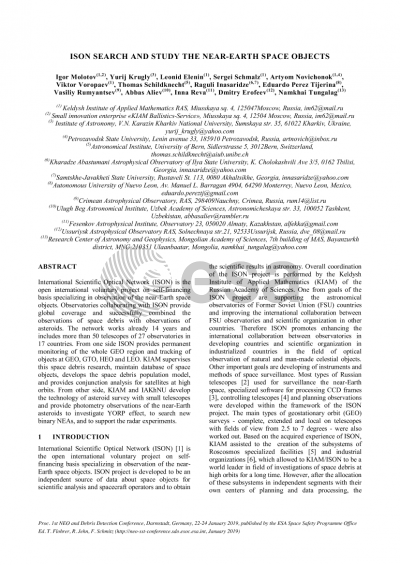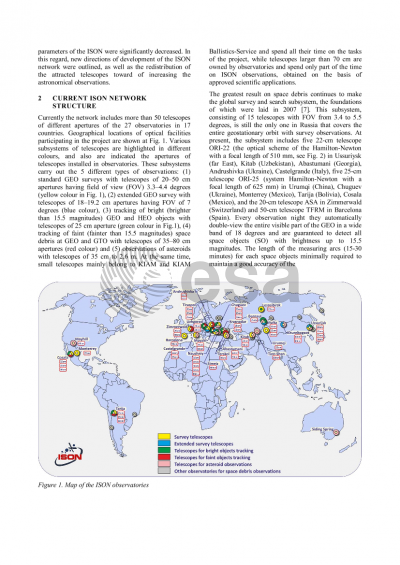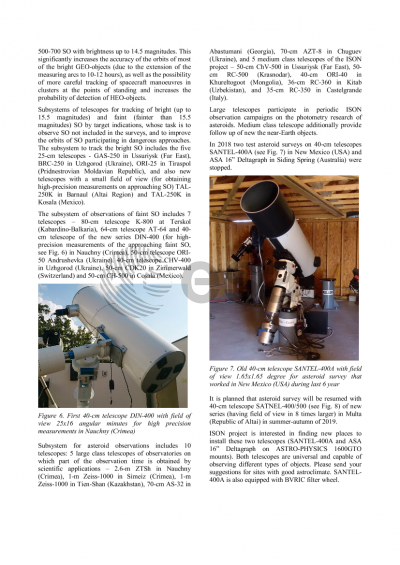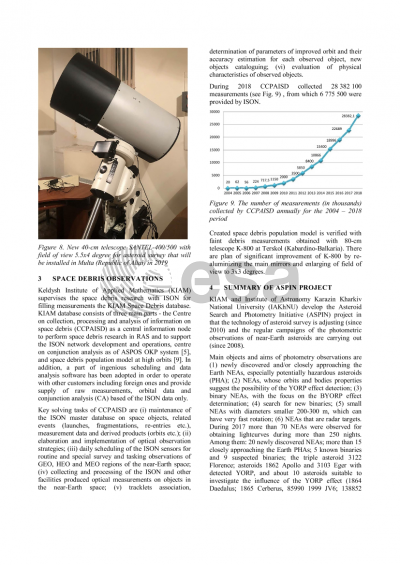Document details

Abstract
International Scientific Optical Network (ISON) is an open international voluntary project on self-financing basis specializing in observations of near-Earth space objects. Observatories collaborating with ISON provide global sky coverage (i.e. telescopes are installed in both hemispheres of the Earth) and successfully combine observations of space debris with observations of asteroids. The network has already been working for 14 years and includes more than 50 telescopes of 27 observatories in 17 countries.
On the one hand, ISON provides permanent monitoring of the whole GEO region and tracking of objects in GEO, GTO, HEO and LEO. KIAM supervises this space debris research, maintains a database of space objects (as a central information node to perform space debris research at RAS), develops a space debris population model, and provides conjunction analysis for satellites in high orbits. During 2017 ISON obtained 6,352,920 measurements (about 28% of total data volume in the KIAM database).
On the other hand, KIAM and IA KhNU develop the Asteroid Search and Photometry Initiative (ASPIN) to adjust asteroid survey technology and to carry out regular photometric observations of near-Earth asteroids. Main objects and aims of photometric observations are (1) newly discovered and/or closely approaching the Earth NEAs, especially potentially hazardous asteroids (PHA); (2) NEAs with orbits and properties suggesting a possibility to detect the YORP effect; (3) binary NEAs, with focus on the BYORP effect determination; (4) search for new binaries; (5) NEAs with diameters smaller than 200–300 m, which can rotate fast; (6) NEAs which are radar targets. During 2017 over 70 NEAs were observed on more than 250 nights to obtain lightcurves. Among them: 20 newly discovered NEAs; more than 15 PHAs closely approaching the Earth; 5 known binaries and 9 suspected binaries; the triple asteroid (3122) Florence; asteroids (1862) Apollo and (3103) Eger with detected YORP, and about 10 asteroids suitable to investigate the influence of the YORP effect – (1864) Daedalus, (1865) Cerberus, (85990) 1999 JV6, (138852) 2000 WN10 and others; binaries (65803) Didymos, (66391) 1999 KW4 and (137170) 1999 HF1 for testing BYORP; NEA (496018) 2008 NU showed two-periodic lightcurves.
ISON asteroid survey under a test mode is directed to elaborate the concept of a “second wave” asteroid survey – a survey with small telescopes which would provide full sky coverage during night to detect fast moving NEAs missed by the dedicated asteroid surveys with the large telescopes. Since 2010 more than one million astrometric measurements were obtained, and in result 1750 main belt asteroids, 17 near-Earth asteroids, 8 comets, 20 Jupiter Trojans, 4 Hilda-family objects, and 4 Centaurs were discovered.
To involve ISON observatories in follow-up observations of discovered NEAs special efforts were undertaken to obtain MPC codes for ISON observatories: 820, D00, D05, D53, C15, H15, К99, L28, L96, N42, O75, Q60.
Preview







